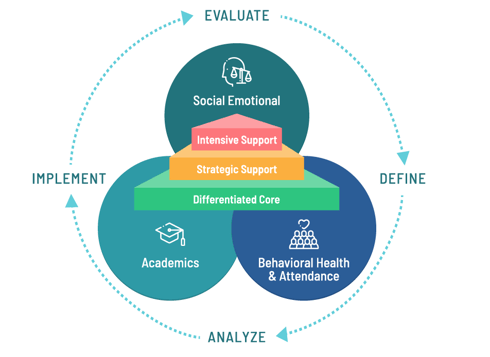
Principal to Principal: 5 Steps to MTSS Success
Principals, YOU are the most essential component in successfully implementing any initiative. At the same time, building a collaborative team of teacher-leaders is the key to long-term success. Just as a structural engineer collaborates with architects to build a strong foundation for a home, principals need to build a coalition of teachers to design and implement an effective Multi-Tiered System of Supports (MTSS) to meet the needs of all students.
If you are wondering if this will actually work . . . well, I did, too! But my experiences as an instructional leader and principal convinced me. As an Instructional Support Specialist, we created a simple school-wide MTSS framework because the school had just been labeled “Improvement Needed” by the state. This basic structure helped us move out of “Improvement Needed” status in one year! A couple of years later, as an Assistant Principal, we used a more elaborate MTSS framework to take a highly rated school from 2 stars to 5 stars of distinction. I was sold on MTSS, so when I moved into a principal role, my team and I built an MTSS that took our elementary school from a D rating to an A rating over the course of five years and through the middle of a pandemic.
I'm excited to share five steps that any principal can take to build and implement an MTSS framework. The structure and collaboration will lead to improved student outcomes along with a more inclusive and supportive environment for students AND teachers!
STEP ONE: Establish a Guided Coalition
The first order of business in building a strong MTSS framework is to establish a Guiding Coalition, or GC. All of the schools I mentioned earlier required a group effort guided by a coalition of teachers and administrators. This is different from your Leadership Team. The sole purpose of a GC is to lead change. In other words, the GC is singularly responsible for leading the MTSS framework at the school and does not lead any other competing initiatives (Hall). This is good news for you because you are not leading the MTSS process alone.
There are two phases this group will need to walk teachers through:
-
-
-
-
-
The difference between RTI and MTSS
-
Developing a culture of continuous improvement
-
-
-
-
RTI vs. MTSS
RTI, or “Response to Intervention,” is a process that has been used nationwide for decades. As a consequence, when MTSS emerged, many districts announced to teachers that RTI has been renamed MTSS, but it is just the same practices we ‘ve always done. I disagree – this belief will hinder your progress! RTI is a more reactive process and MTSS is a comprehensive, proactive process. The RTI process usually occurs within a one-teacher, one-classroom model, in which the teacher waits for a student to show significant signs of struggling and then reacts by scheduling an RTI meeting. The MTSS process, on the other hand, establishes systems by which teachers continuously review student data to determine which students are struggling with a specific skill so that intervention can be applied before the students show significant skill deficits. A comprehensive MTSS framework ensures ALL students are provided with what they need whether it is intervention, enrichment, or social-emotional learning skills. This understanding is fundamental to shifting teachers' mindsets toward the need for change.
A Culture of Continous Improvement
As the Guiding Coalition follows the MTSS workflow (see diagram) it is important they are intentional about 3 things:
- Supporting teachers so they feel secure to try new things
- Communicating clearly about their systems and structures that make their workflow effective
- Building trust among teachers so they are comfortable sharing data and their students for intervention
It is possible for individual teachers who struggle with change to develop over time, especially with the help of your Guiding Coalition. In order to embark on your MTSS journey, your Guiding Coalition will need to establish an atmosphere of forgiveness towards one another when mistakes are made. Mistakes are just part of the learning process.
STEP TWO: Change Perspectives From MY to OUR
Start small with a team that already trusts each other, or maybe even use teachers from your GC to model the process. When other teachers start to notice teams of teachers sharing responsibility and the impact it has on student achievement, it will spread like wildfire. When I was an Assistant Principal, I started an MTSS framework with just the Second-grade team. It was not an easy sell, but I convinced them to give me one 9-week grading period, and then we could analyze the data to determine our next steps. After 9-weeks, they were intrigued and wanted to continue. By the end of the year, my principal and other grade-level teams were on board to implement our MTSS framework school-wide. As I shared earlier, after two years of implementation, this Title One school went from 2 stars of distinction to 5 stars!
Not only did we see student growth, but teachers from this team showed growth as well. One teacher became the instructional coach. Another teacher from this team became the Third-grade team leader, then our instructional coach, then our Assistant Principal, and eventually an MTSS consultant for a state and university-based grant. Talk about teacher growth!
STEP THREE: Attend to the Details
Now that you have a solid MTSS foundation with the support of your GC, it is time to attend to the details that will allow your MTSS to function efficiently. The best place to start is with the Master Schedule. TIP: When you form your GC, include an educator who is talented at scheduling and managing details.
Master Scheduling
As a principal, I utilized paraprofessionals and retired teachers as tutors. Their time was limited, so it meant that we built our intervention and enrichment time to stagger each grade from 8:00-11:00 a.m. to give them time for other responsibilities. To ensure ALL students' needs were met, we gave teams of teachers relief from dismissal duties to meet as Professional Learning Communities once a week. These times were all built into the Master Schedule. When creating the Master Schedule, it is important to include two things:
- Consistent time for intervention and enrichment
- Routine time for teachers to share in data-based decision-making groups.
Access to Data
This work can be cumbersome without easy access to student data, intervention plans, and collaboration tools. Teacher time is limited, and I would prefer to have as much of that time spent with students as possible, rather than chasing paper forms and logging into multiple sites to track down needed information. An MTSS platform like Branching Minds makes this work feasible, with all the data, plans, meeting notes, and intervention instructions in one place. Teams that make good use of an MTSS platform can drastically cut down meeting time as well.
|
Curious how you can make your MTSS work more feasible? |
STEP FOUR: Assess Your MTSS Practice
It is imperative that you measure the growth of your teachers toward full MTSS implementation. As a principal, I used a rubric called the Professional Learning Community Organizer (PLCO). Although not a full rubric for MTSS implementation, it was useful for these teachers to self-evaluate their implementation of the MTSS framework as a team. They reflected on their growth from the initiating phase to full implementation. Teachers used this evaluation three times a year to determine the effectiveness of implementation and plan adjustments as needed.
The good news is that Branching Minds now provides a full set of implementation rubrics that can help school-level (and district-level!) teams asses their full MTSS practice. These are free and include step-by-step instructions to help schools build out their framework and support teachers in implementation.
💡 ADDITIONAL RESOURCE: A Guide to MTSS Self-Assessment
STEP FIVE: Share With Stakeholders
Once your GC has built a well-functioning MTSS framework, you will want to share the success with another grade level, principals, or district personnel. Whatever your audience, develop a visual that clearly conveys the components of your MTSS framework. The process of developing a visual will also help your GC determine how all of the systems and structures integrate into one MTSS framework.
Conceptual Framework
Developing a conceptual framework, or visual, of your school’s MTSS framework makes it much easier to share the key components with stakeholders. An example of my school’s conceptual framework is below, but there are many other examples of district and school-based MTSS frameworks (Parsons).

If this Conceptual Framework seems a bit overwhelming, we didn’t start there., We first used a picture that conveyed how we wanted our systems and structures to function in our MTSS framework. This arch made of stones is the visual representation we used as a GC when we first began this journey. We thought this picture represented the systems and structures working in sync together to support each student.

Conclusion
You are not alone on your MTSS journey! A guiding coalition is your ace in the hole to make a smooth transition from RTI to MTSS. If you are still thinking that you need help to start your GC, you are also not alone! Campus and district leadership have different levels of experience with MTSS and/or implementation science and may need training and coaching before starting with their own staff. Don’t hesitate to reach out for help.
Branching Minds consultants are experienced educators who provide coaching for both principals and district administrators in constructing a strong MTSS infrastructure. Request a meeting with our Professional Services today to see how we can support your journey as a principal.
Takeaways:
- Establish a Guiding Coalition whose sole responsibility is to lead the implementation of the MTSS framework.
- Attend to both the external details like scheduling and the internal work of shifting mindsets toward collaborative work.
- Improved student achievement will happen, so be ready to share with a visual representation of your MTSS framework.
🚀 Make Your MTSS Efficient and Effective With the Branching Minds Web PlatformLearn more by requesting a demo today!
|
Citations:
Elements of the Arizona State University’s Next Education Workforce: https://workforce.education.asu.edu/wp-content/uploads/2021/07/Elements-of-the-Next-Education-Workforce-v4.0.pdf
Professional Learning Community Organizer Rubric: https://www.plcassociates.org/assessments/informal/professional-learning-community-organizer-plco/
Parsons, Valerie. Multi-Tier Systems of Support and Their Impact on a Title 1 School. MTSS Conceptual Framework (p. 9-13, 47-48) https://digital.library.unt.edu/ark:/67531/metadc1833509/

Dr. Valerie Parsons
Valerie has been in education for 26 years including 6 years as a teacher in elementary and middle school and 5 years as an instructional coach in the areas of Reading, English Language Development, RTI, and MTSS. Dr. Parsons started her journey as an educational administrator 15 years ago as a coordinator at the district office in professional learning, curriculum and instruction, and health education. For the past 8 years, she has served as an Assistant Principal and Principal where she worked in Title I schools and developed systems and structures for an MTSS framework that showed growth in student achievement. Dr. Parsons analyzed data for her dissertation from pre-existing data before and after the implementation of her MTSS framework. The data showed statistically significant results in Reading achievement.
Dr. Parsons is dedicated to helping districts and schools achieve success in student learning by building systems and structures that support an effective MTSS framework. She believes the effective use of data, through Branching Minds’ technology, supports the work of teachers and administrators to make learning equitable for ALL students.
Dr. Parsons is the author of the MTSS Playbook Series, including
MTSS Playbook Series: Beginning-of-Year Gameplan for School and District Leaders and
MTSS Playbook Series Middle-of-Year Momentum: Halftime Strategies for School and District Leaders published by Branching Minds.
Related Posts
Tagged: MTSS Infrastructure, Leadership in MTSS






Comments (0)